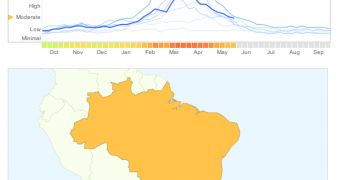Last week, Google introduced Correlate, a Labs tool which allows users to find links between different search terms and trends. It can be a fun tool and it can be used for some interesting research, but it also comes in handy in more surprising ways, for example as an early warning sign for dengue fever outbreaks.
Of course, considering that Google Correlate has its origins in Google's Flu Trends tool, it's not that surprising that the same people have now created Google Dengue Trends, based on technology developed and perfected for the Labs tool.
"We’ve heard from many researchers who want to mine this data for new discoveries about economics and public health—much like we designed Google Flu Trends to give an early warning about flu outbreaks. We hope they’re able to make useful discoveries with Google Correlate," Vikram Sahai, a software engineer at Google, wrote.
"While building Google Correlate, we used it to create an early warning system for another important disease. Google Dengue Trends in Bolivia, Brazil, India, Indonesia and Singapore provides an additional surveillance tool for a disease that affects about 100 million people each year," he explained.
Google Dengue Trends is very similar to Flu Trends, for obvious reasons. It relies on search data on several countries affected by the disease that also have a large enough internet population. By keeping an eye on search trends, outbreaks can be spotted very early on.
Brazil and India need no introduction, they're one of the fastest rising internet markets in the world. Indonesia is also coming fast from behind, it's already the second biggest country on Facebook. Bolivia is also growing fast, Twitter has become very popular in the country for example.
This is important, since Google needs to have a large enough user base, from all walks of life, for the data to be relevant, which is why the tool is only available in so few countries.
Dengue affects 50 million to 100 million people each year and is considered endemic, meaning infection rates are sustained, in 110 countries. It's not fatal in most cases, but there are no vaccines and no treatment against it.

 14 DAY TRIAL //
14 DAY TRIAL //